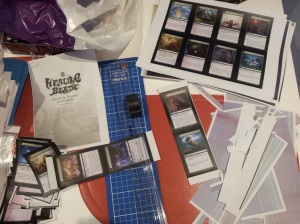via Is your PhD stuck on Mars? Apply the Martian Method
I read this blog post this morning, and it resonated with me. Much of what the author describes is what I went through last year. Below is my first blog post in a long time. I reflect on how I have moved my PhD forward, using the Martian Method as an analogy.
Firstly, the ‘Stay alive’ was the most important part. I sought support from student services and counselling as soon as I realised my PhD world was unravelling. Of course, I was also supported by my husband, family and friends- they knew there was a problem much earlier than I would admit, and were my first port of call. They made sure I was fed, encouraged me to take breaks, have a coffee (well- chamomile tea- caffeine was not good for my stress levels) and go for walks. Those in my workplace bought me little trinkets or flowers or left notes on my desk to let me know they were thinking of me. There were many hugs too.
As part of ‘stay alive’ I did cut off some of my contacts with the outside world, like this blog, which I just couldn’t write in for a multitude of reasons. For some reason, today, over twelve months since my PhD world unravelled, the linked blog post from the thesis whisperer has prompted me to write again.
My “call earth” included the amazing people who supported me to ‘stay alive’ and who believed in me when I didn’t. I also extended my support crew by contacting some people I had lost touch with over the course of my studies, these people knew me when I was strong, and reminded me how to be that person again. It took a while, but this act of reaching out and extending my support crew helped me reconnect with who I used to be before I got lost in academia and my studies. It has led to me taking my life off the ‘hold pattern’ it had been in for almost seven years. Basically, I stopped holding my breath, waiting to be finished my thesis, and got on with life. I got a new job, changed my workplace, and became active in a professional association again. I am balancing my time differently to meet various deadlines and expectations. I am also saying ‘no’ to certain things, and ‘yes’ to others; like demonstrating at a local craft afternoon, entering my craft in an art show and making time for family fun too. These are the things which ground me, fill my soul and give me perspective. They had become a source of guilt during the time I put everything on hold. Now I let them be a joy and feel so much better for it.
The “just begin” I feel I need to add ‘again’ to. I have begun my thesis writing again and again. Each time the focus is sharper and the argument I am making is clearer. But it’s not just about beginning the writing: I read a range of other theses, I went to writing workhops, I re-visited my data sets and analysis, and I re-wrote my third and fourth full versions of my thesis over the last twelve months. My fifth version is being shaped now and I feel so much more in control and sure of my thesis this time. Part of my ‘begin’ was building a new supervisory team, and building the personal confidence to keep moving forward to finish my thesis.
So, here I am. Still determined to complete what I began. Stronger than I was twelve months ago. I am certain that post-PhD life will be great, but I am not waiting until then to live my best life. Learning to live my life alongside the PhD has been a revelation- thanks to all of my support crew for helping me find my joy again.
Until next time
Fiona T




